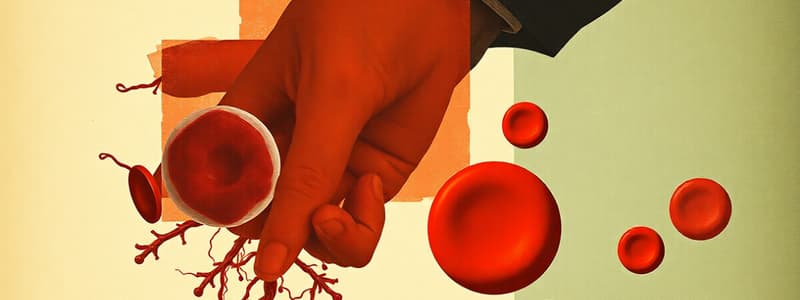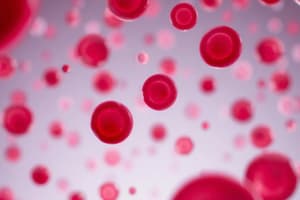Podcast
Questions and Answers
What is the primary function of blood in terms of temperature regulation?
What is the primary function of blood in terms of temperature regulation?
- It facilitates the exchange of gases in the lungs.
- It helps maintain the body's core temperature. (correct)
- It transports hormones that regulate metabolic processes.
- It directly absorbs heat from surrounding tissues.
Which of the following components accounts for the majority of blood volume?
Which of the following components accounts for the majority of blood volume?
- Platelets
- Plasma (correct)
- White blood cells
- Red blood cells
Which function of blood is primarily associated with maintaining the body's internal environment?
Which function of blood is primarily associated with maintaining the body's internal environment?
- Acid-base balance stabilization (correct)
- Regulation of body temperature
- Transport of oxygen to tissues
- Waste removal from cells
Which of the following is NOT a function of blood?
Which of the following is NOT a function of blood?
What primarily makes up plasma, the liquid component of blood?
What primarily makes up plasma, the liquid component of blood?
What role does plasma NOT play in the body?
What role does plasma NOT play in the body?
Which statement about formed elements is TRUE?
Which statement about formed elements is TRUE?
How does a decrease in RBCs affect blood viscosity?
How does a decrease in RBCs affect blood viscosity?
What is the primary characteristic of a buffy coat in a blood sample?
What is the primary characteristic of a buffy coat in a blood sample?
What term describes the process of blood cell formation?
What term describes the process of blood cell formation?
What is the primary role of hemoglobin in red blood cells?
What is the primary role of hemoglobin in red blood cells?
Which factor contributes to the difference in hematocrit levels between men and women?
Which factor contributes to the difference in hematocrit levels between men and women?
What is the maximum number of oxygen molecules one hemoglobin molecule can bind?
What is the maximum number of oxygen molecules one hemoglobin molecule can bind?
What is the average lifespan of a red blood cell before it is broken down?
What is the average lifespan of a red blood cell before it is broken down?
Which component of hemoglobin contains iron and is essential for oxygen binding?
Which component of hemoglobin contains iron and is essential for oxygen binding?
What role does lymphatic tissue play in hematopoiesis?
What role does lymphatic tissue play in hematopoiesis?
Which feature of red blood cells (RBCs) significantly aids in their function of gas exchange?
Which feature of red blood cells (RBCs) significantly aids in their function of gas exchange?
How does the internal structure of red blood cells affect their ability to replicate?
How does the internal structure of red blood cells affect their ability to replicate?
What distinguishes red bone marrow from lymphatic tissue in terms of hematopoiesis?
What distinguishes red bone marrow from lymphatic tissue in terms of hematopoiesis?
What characteristic of red blood cells allows them to navigate through tiny capillaries effectively?
What characteristic of red blood cells allows them to navigate through tiny capillaries effectively?
What condition results from an excess of bilirubin in the tissues?
What condition results from an excess of bilirubin in the tissues?
Which of the following is a consequence of polycythemia?
Which of the following is a consequence of polycythemia?
What primarily causes iron deficiency anemia?
What primarily causes iron deficiency anemia?
What is the primary role of hemoglobin in the blood?
What is the primary role of hemoglobin in the blood?
Which component of the blood is most involved in immune response?
Which component of the blood is most involved in immune response?
What role do neutrophils primarily play in the immune system?
What role do neutrophils primarily play in the immune system?
Which characteristic distinguishes granulocytes from agranulocytes?
Which characteristic distinguishes granulocytes from agranulocytes?
What can be inferred about eosinophils based on their location?
What can be inferred about eosinophils based on their location?
How do worn-out neutrophils contribute to the body's response to infection?
How do worn-out neutrophils contribute to the body's response to infection?
What is the general function of white blood cells (WBCs)?
What is the general function of white blood cells (WBCs)?
Which function is primarily associated with basophils?
Which function is primarily associated with basophils?
What distinguishes agranulocytes from other types of white blood cells?
What distinguishes agranulocytes from other types of white blood cells?
How do T lymphocytes contribute to long-term immunity?
How do T lymphocytes contribute to long-term immunity?
Which of the following best describes the lifespan of lymphocytes?
Which of the following best describes the lifespan of lymphocytes?
What is the role of B lymphocytes in the immune response?
What is the role of B lymphocytes in the immune response?
What is the primary characteristic of monocytes in the bloodstream?
What is the primary characteristic of monocytes in the bloodstream?
Which statement correctly describes the role of platelets in hemostasis?
Which statement correctly describes the role of platelets in hemostasis?
Which statement regarding leukemia is accurate?
Which statement regarding leukemia is accurate?
What is the typical lifespan of monocytes in the bloodstream before they migrate into tissues?
What is the typical lifespan of monocytes in the bloodstream before they migrate into tissues?
What does a complete blood cell count (CBC) specifically provide information about?
What does a complete blood cell count (CBC) specifically provide information about?
What triggers the secretion of erythropoietin (EPO) from the kidneys?
What triggers the secretion of erythropoietin (EPO) from the kidneys?
Which statement accurately describes the maturation process of reticulocytes?
Which statement accurately describes the maturation process of reticulocytes?
What happens to hemoglobin when red blood cells are broken down?
What happens to hemoglobin when red blood cells are broken down?
How does the production of erythropoietin change with the levels of red blood cells?
How does the production of erythropoietin change with the levels of red blood cells?
What role do macrophages play in the lifecycle of red blood cells?
What role do macrophages play in the lifecycle of red blood cells?
What initiates the formation of a platelet plug during hemostasis?
What initiates the formation of a platelet plug during hemostasis?
Which component is NOT directly involved in the formation of a blood clot?
Which component is NOT directly involved in the formation of a blood clot?
What is the end result of both the extrinsic and intrinsic pathways in the clotting process?
What is the end result of both the extrinsic and intrinsic pathways in the clotting process?
What does the term 'vascular spasm' refer to in the hemostasis process?
What does the term 'vascular spasm' refer to in the hemostasis process?
Which statement accurately describes the role of platelets during the clotting process?
Which statement accurately describes the role of platelets during the clotting process?
Flashcards are hidden until you start studying
Study Notes
Blood Functions
- Blood is a connective tissue that functions as a transport medium, delivering oxygen and nutrients, removing waste, and protecting the body against infection.
- Blood also plays a role in acid-base balance and temperature regulation.
Components of Blood
- Blood consists of plasma and formed elements.
- Plasma makes up 55% of blood and is primarily water, containing proteins, clotting factors, and substances that regulate fluid volume.
- Formed elements, including red blood cells (RBCs), white blood cells (WBCs), and platelets, constitute 45% of blood.
Red Blood Cells (RBCs)
- RBCs transport oxygen to cells and remove carbon dioxide.
- They are biconcave discs, lacking a nucleus and DNA, allowing for efficient oxygen diffusion.
- RBCs have a lifespan of 120 days and are produced in the red bone marrow.
- Hemoglobin, a red pigment containing iron, gives blood its color and binds to oxygen for transport.
Hematopoiesis
- Erythropoiesis is the process of RBC production, regulated by erythropoietin (EPO), a hormone secreted by the kidneys.
- EPO is released in response to low oxygen levels and stimulates red bone marrow to produce RBCs.
- Damaged or old RBCs are broken down by macrophages in the liver and spleen.
- Hemoglobin breakdown releases iron, which is recycled for new hemoglobin synthesis, and bilirubin, which is excreted in bile.
White Blood Cells (WBCs)
- WBCs are the body's defense against infection and are divided into granulocytes and agranulocytes.
- Granulocytes, including neutrophils, eosinophils, and basophils, have visible granules in their cytoplasm.
- Agranulocytes, including lymphocytes and monocytes, lack visible granules.
- Lymphocytes are responsible for long-term immunity, including T lymphocytes (direct attack) and B lymphocytes (antibody production).
- Monocytes transform into macrophages, aggressive phagocytic cells that engulf bacteria, debris, and cancerous cells.
Platelets
- Platelets, also called thrombocytes, are essential for blood clotting, a process called hemostasis.
- Hemostasis involves three main stages: vascular spasm, platelet plug formation, and coagulation.
- Vascular spasm is the immediate constriction of the blood vessel to reduce blood flow.
- Platelet plug formation involves sticky platelets adhering to the damaged vessel wall and clumping together.
- Coagulation, or blood clotting, is a complex process involving clotting factors that culminate in the formation of a fibrin mesh, stabilizing the clot.
- The extrinsic pathway is initiated by tissue injury outside the blood vessel, while the intrinsic pathway is triggered by factors within the blood.
- Both pathways converge at the common pathway, leading to prothrombin activation and fibrin formation.
Blood Tests
- A complete blood count (CBC) is a common blood test that provides information about RBCs, WBCs, and platelets.
- Abnormal blood cell counts can indicate disease or infection.
Disorders
- Anemia is a deficiency in RBCs or hemoglobin, leading to reduced oxygen-carrying capacity.
- Polycythemia is an excess of RBCs, increasing blood volume and viscosity.
- Leukemia is cancer of the blood or bone marrow characterized by high WBC counts.
Studying That Suits You
Use AI to generate personalized quizzes and flashcards to suit your learning preferences.




